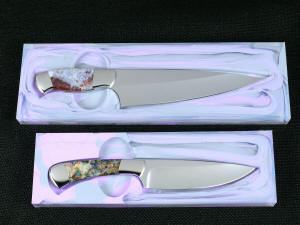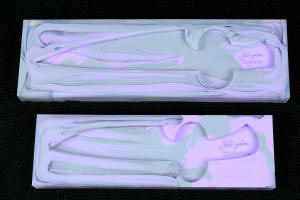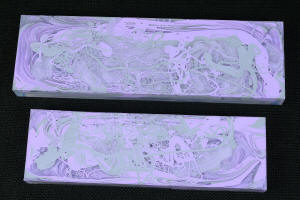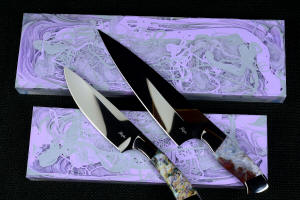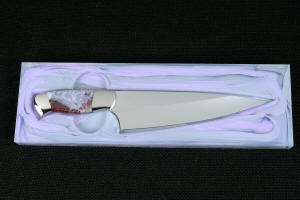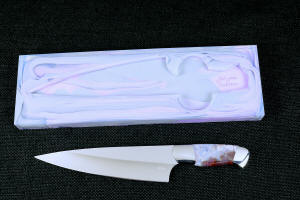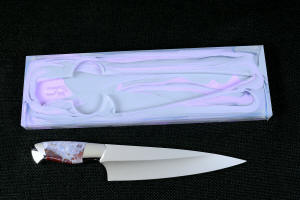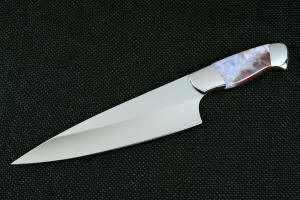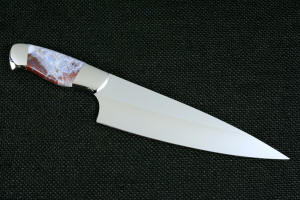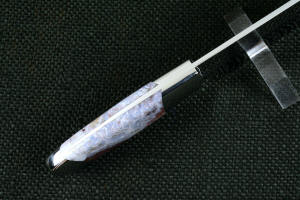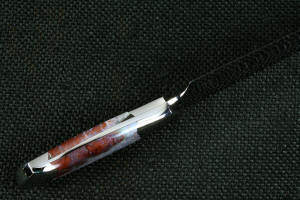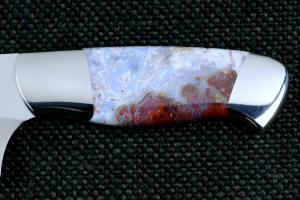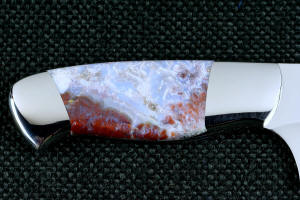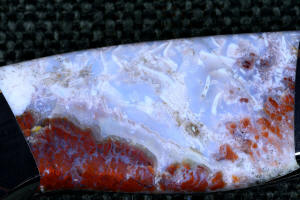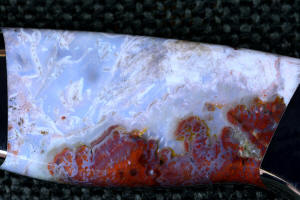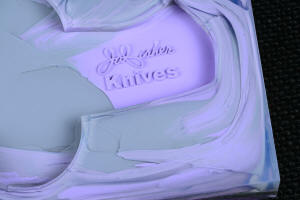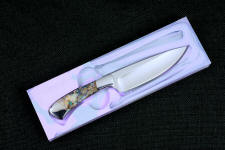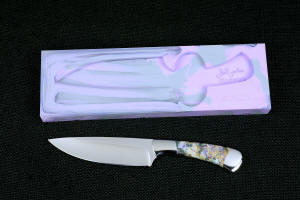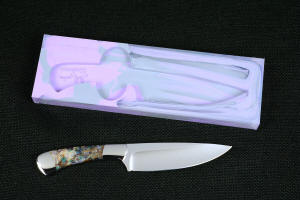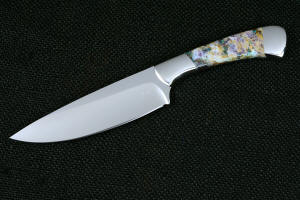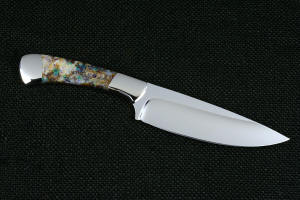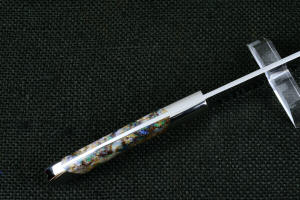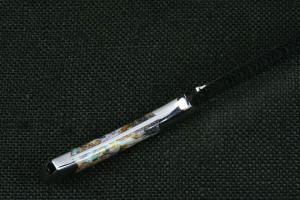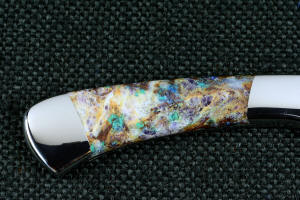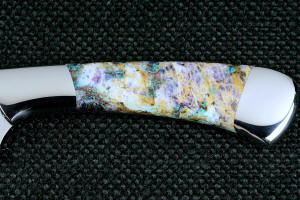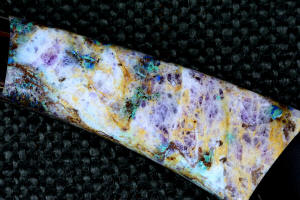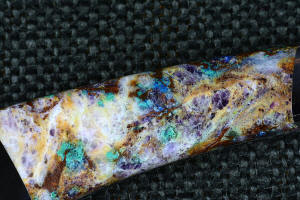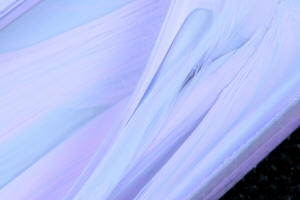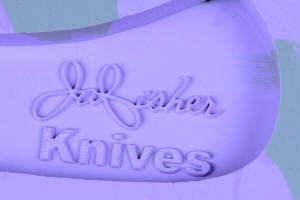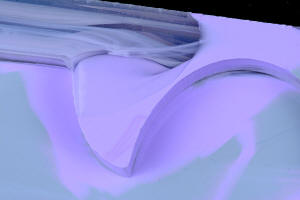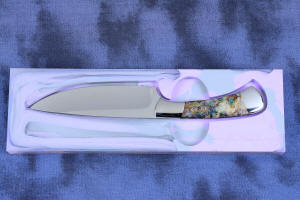Cygnus ST and Corvus Custom Chef's Knives
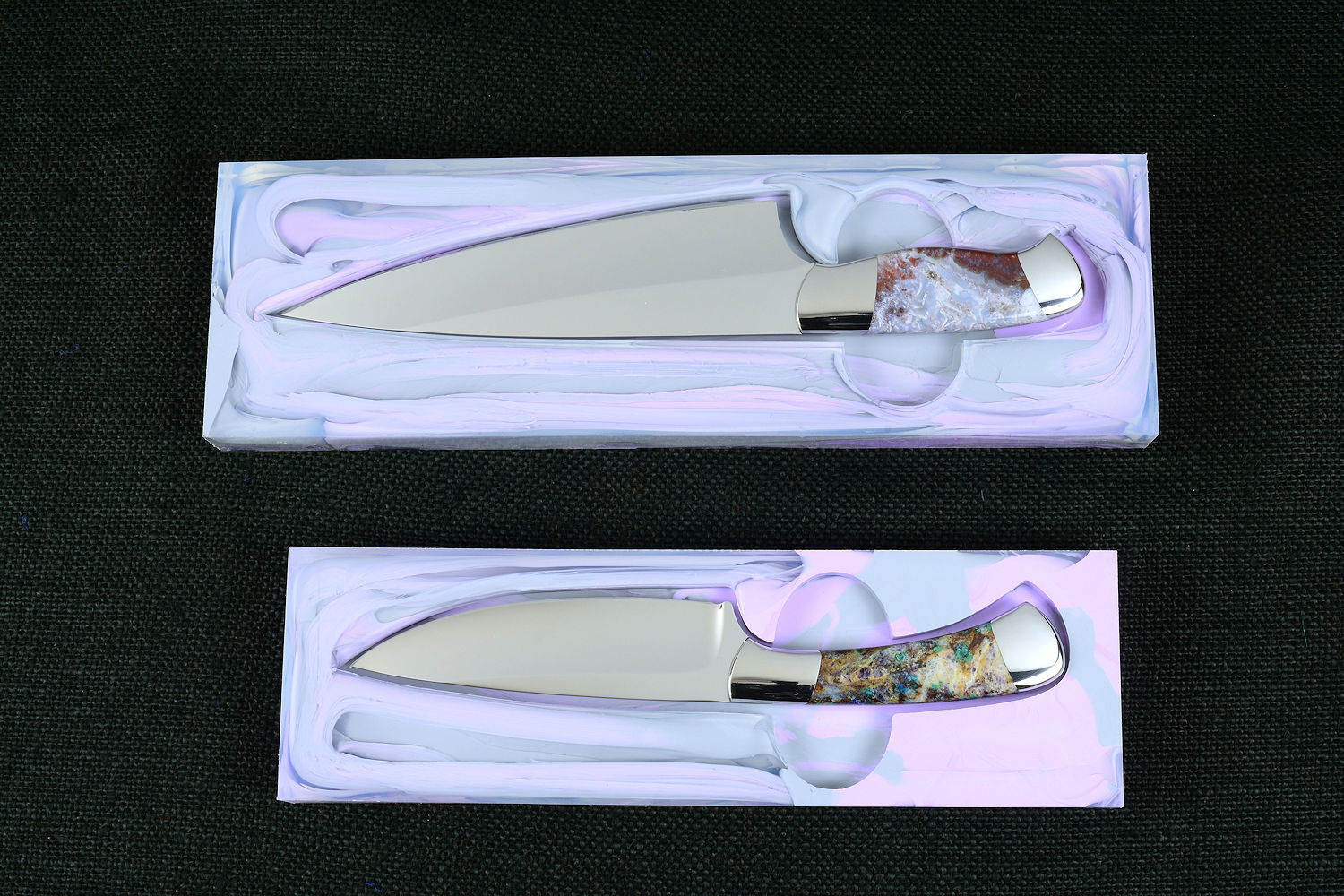
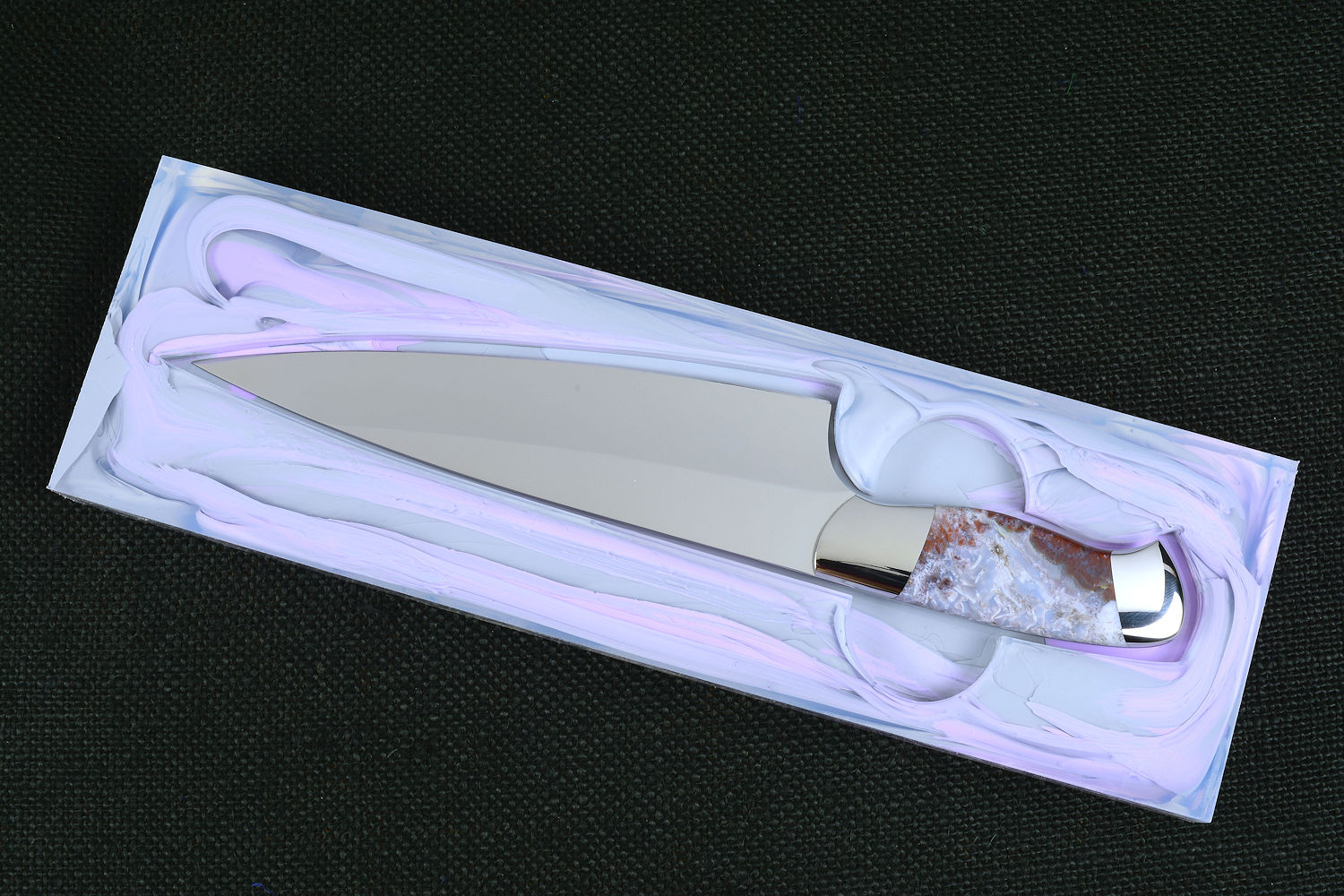
"Corvus" Fine Handmade Custom Chef's Knife
- Size: Length overall: 11.5" (29.2 cm), Blade Length:
7.5" (19.1 cm), Thickness: 0.116" (2.95 mm)
- Weight: Knife: 9.4 oz. (267 grams) Prise: 2.0
lbs. (907 grams)
- Blade: 440C high chromium martensitic stainless steel blade, T3 deep cryogenically treated with triple tempering to 58 HRC
- Bolsters, Fittings: 304 Austenitic Stainless Steel, Mirror polished
- Handle: Bay of Fundy Agate (Fossil) Gemstone (Nova
Scotia)
- Prise: Hand-dyed, hand-cast high strength
silicone
- Knife: Corvus is the Latin name for the family
of crows and ravens. I named this design because the shape of the
Corvus blade reminds me of the incredibly useful and resourceful
beak of the birds, one of nature's very best tools. The Corvus knife
reflects that; it's just the right size for most kitchen and chef's
work, without being to large and unwieldy. This is a thin, hard, and
incredibly sharp knife, with a good heel for the board and a perfect
curve for the chef's handwork. Our family likes this design so much,
it's the design pattern for our main knife in our own home kitchen.
- The steel I chose for this knife is
Food Contact Safe 440C high chromium martensitic stainless
steel, my most requested steel for a reason. When properly
treated, it's a dependable, reliable workhorse of extremely
high corrosion resistance, good toughness and high wear
resistance. The high chromium of 440C along with the high
carbon and moderate molybdenum results in profuse chromium
carbides, increasing corrosion resistance as well as wear
resistance. To bring this steel to its zenith, I used my
proprietary T3 deep cryogenic process in heat treating this
blade; it's a highly detailed, extremely sophisticated
process that takes 33 individual steps and takes over a week
long. The result of this is an incredibly wear-resistant
blade that has extremely high carbide development, fine
grain, and extremely high corrosion resistance. Asperity is
reduced; the microstructure development is superior to any
other typical handmade knife, and far above any factory or
manufactured knife. This is, simply put, 440C at its very
finest advanced condition. The grind for this knife blade is
hollow, leaving a very thick and strong spine with a
moderately thin, tough cutting edge. I ground this blade
with a 12" contact wheel for an extremely thin cutting edge
that has great longevity after generations of sharpening. To
give you an idea, I sharpen our Corvus once or twice a year
only; it will well outlast me or my heirs!
- I bolstered the knife with zero-care 304 high chromium, high
nickel stainless steel bolsters, which are contoured, rounded and
finished for a comfortable feel. The bolsters are secured with
zero-clearance peened pins and dovetailed to bed the
handle scales. The rear bolsters
are wide and support the rear quillon that locks the handle
into the hand.
- The handle scales of this knife are
very, very special. This is Bay of Fundy Agate, coming from
the area between Nova Scotia and New Brunswick
provinces in Canada. The bay boasts of the highest tides in
the world, with striking and fantastic intensely old fossil and geological
deposits, and this gemstone does not disappoint. On first
glance, you might notice that the gem is an agate, with
clear areas and a purplish-lavender tint with hints of
reddish carmine. Study closer and the fascinating
fossilized nature of this gem becomes clear. Please
scrutinize
the photo magnifications below; this is some of the most
striking fossil I've ever encountered. I don't know the
nature of the once-living remains in this rock, it's many
millions of years, perhaps billions of years old, and
these might be some of the earliest creatures on the planet.
The tubular and segmented structures float throughout the
agate; it's like no other material. Usually, in fossils, the
rock is not agate but jasper or other opaque material,
because fossils are formed by sedimentation. Clearly put,
agates cannot be formed by sedimentation, yet, here is a
fossil in agate! Also,
in agates, the translucency is typically formed in
fortifications, layers like a moat around a castle, with
"flames" of intrusive colors brought into the stone by water
deposition and self-forming crystallization. This is none of these; this is a floating,
transparent agate of once living things. I truly wonder at
how this fossil was formed; I've seen nothing else like it. The agate is hard and solid, incredibly tough and dense and
takes a high vitreous polish that is smooth and glassy. This
is a handle that is more fascinating the closer and more
intensely it's scrutinized.
- This great feeling blade has a good
curve and heel for great board work; I love working with
meats, vegetables, dicing, trimming, and chopping. It's a
great all around knife with a tight feel, and necking up on
the blade by pinching the spine is effortless. It cleans
with a soapy brush and rinse, and air dry. It's smooth with
no filework to catch debris and, of course, it's entirely
food-contact safe.
- Prise: New to the field and new to the world,
in early 2020, I developed the prise. This is a substantial block of
hand-cast 800 psi tensile strength silicone, grippy and tough and completely food contact
safe. This 2 pound silicone form is heat-resistant to 450°F (232°C) and
is the perfect companion for the fine chef's knife. More than a rest
for the knife, it's storage, safety, protecting the knife from other
utensils, stopping movement, creating a safe zone for the knife
during use (instead of laying it bare on the countertop or cutting
board where it could spin around dangerously). It's easy to clean, extremely durable, and won't move on the
counter due to its "grippy" nature. Nothing sticks to it, and a
quick rinse in soapy water and rinse is usually all that is required to
clean it. I custom-dyed this prise at my client's wishes and
guidance, in a light battleship gray, with lavender swirls and
areas, floating in a clear field. In bright light,
the silicone seems to change color to a hint of blue. As with
all of these silicone creations, it's entirely unique and changes
depending on the lighting. Even the back of the prise is a work of
art, like an canvas of gentle color. When the knife is to
the right side or at the top of the cutting board, the cutting edge
of the knife and point face away from the user for safety.
Please take the time to
read more about the prise at this bookmark, and see how our own
family uses this wonderful adjunct to the kitchen knife.
- A beautiful and durable working and skinning knife with a
striking fossil gemstone handle.
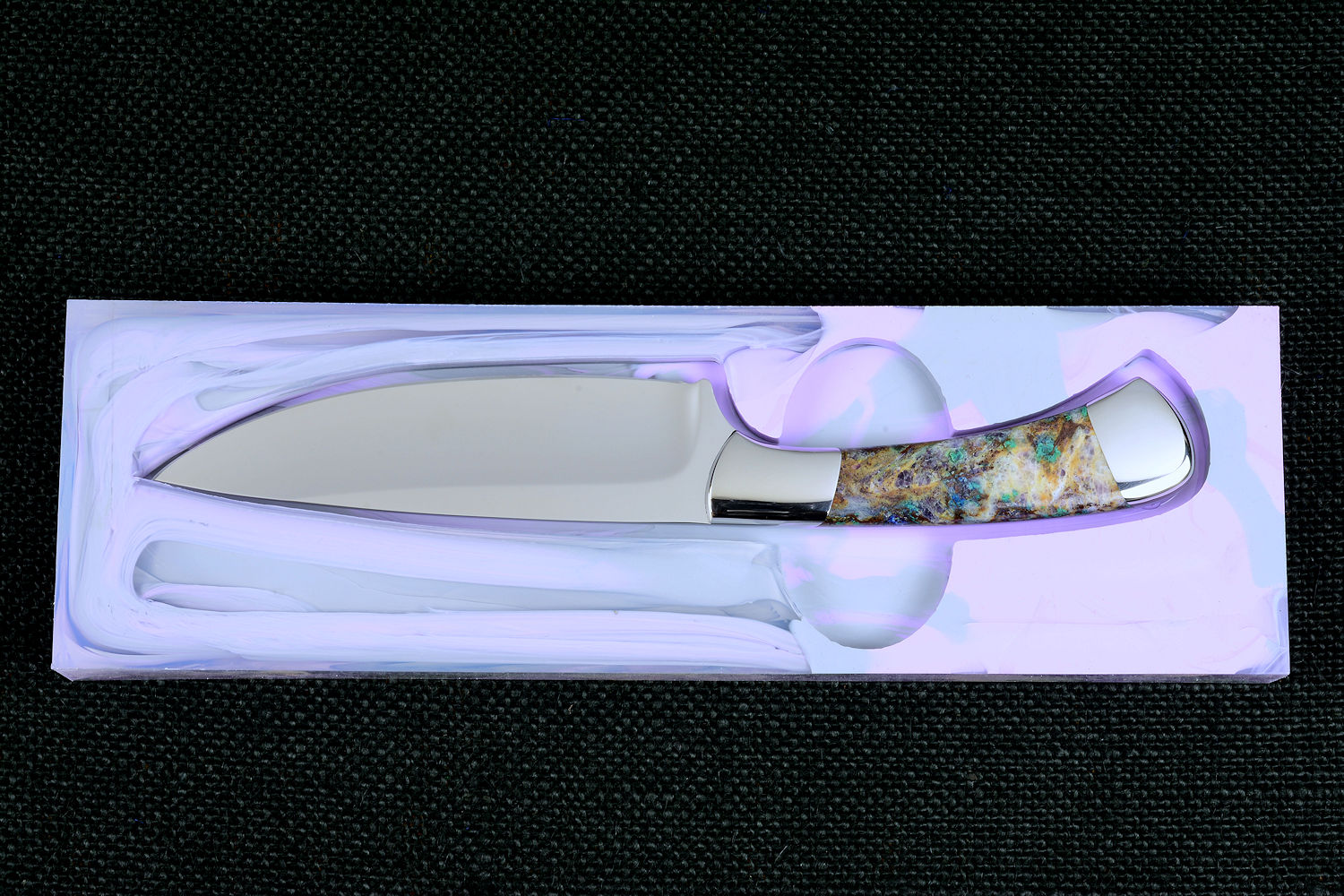
"Cygnus ST" Fine Custom Chef's Knife
- Size: Knife: Length overall: 9.9" (21.1 cm), Blade Length:
5.25" (11.4 cm), Thickness: .125" (2.9 mm)
- Weight: Knife: 7.3 oz. (136 grams) Prise: 1
lb., 6.0 oz. (113 grams)
- Blade: CPM 154CM high molybdenum powder metal stainless steel,
T3 deep cryogenically treated, hardened and tempered to 61.5HRC, mirror polished
- Bolsters, Fittings: 304 Austenitic Stainless Steel, mirror polished
- Handle: Kaleidoscope Stone Gemstone (Utah)
- Prise: Hand-dyed, hand-cast high strength
silicone
- Knife: The Cygnus is named for the
constellation of the swan in the northern sky. This Cygnus has a
shortened blade, thus the designation ST. I created it for a
lighter, smaller version of my popular Cygnus style, which has found
a great home among chefs for its clean, substantial, yet fine blade.
This Cygnus ST has a very thin, very hard blade, made for slicing
, trimming, and most medium-sized tasks.
- The steel I chose for his knife is
CPM154CM, a powder metal tool steel, a high technology steel
known for extremely even distribution of alloy elements and
a uniform microstructure. It's a high molybdenum stainless
steel, and the molybdenum aids in forming nucleation sites
for complex carbide development. The moly also increases the
toughness dramatically, resulting in a blade that's
extremely durable. This allows me to temper the steel at a
higher overall hardness, for great wear resistance as well.
The high chromium and high carbon results in profuse
chromium carbides, increasing corrosion resistance as well
as wear resistance. To bring this steel to its zenith, I
used my proprietary T3 deep cryogenic process in heat
treating this blade; it's a highly detailed, extremely
sophisticated process that takes 33 individual steps and
takes over a week long. The result of this is an incredibly
wear-resistant blade that has extremely high carbide
development, fine grain, and extremely high toughness.
Asperity is reduced; the microstructure development is
superior to any other typical handmade knife, and far above
any factory or manufactured knife. This is, simply put,
154CM Powder Metal steel at its very finest advanced
condition. The grind is hollow and deep, well-matched and
beautifully mirror polished. I tempered this knife to a
high hardness of 61.5 because the geometry and steel type
will support it, maintaining the sharp cutting edge an extremely
long time. The blade heel is fully thick to the base, protecting
the hand from moving forward for lighter tasks. The knife feels
substantial and like a dedicated working tool in the hand.
- I bolstered the knife with zero-care 304 high chromium, high
nickel stainless steel bolsters, which are contoured, rounded and
finished for a comfortable feel. The bolsters are secured with
zero-clearance peened pins and dovetailed to bed the
handle scales. The rear bolsters
are wide and support the rear quillon that locks the handle
into the hand.
- The handle scales of this knife I made in
Kaleidoscope Stone, a gemstone from Utah. It's not a singular
mineral, it's actually a combination of chrysocolla, fluorite,
and malachite, with prisms of small crystal structures
throughout. It's a striking combination of minerals and has
intricate patterns that fascinate the closer they are examined.
The colors match the prise (next) well.
- Prise: New to the field and new to the world,
in early 2020, I developed the prise. This is a substantial block of
hand-cast 800 psi tensile strength silicone, grippy and tough and completely food contact
safe. This 2 pound silicone form is heat-resistant to 450°F (232°C) and
is the perfect companion for the fine chef's knife. More than a rest
for the knife, it's storage, safety, protecting the knife from other
utensils, stopping movement, creating a safe zone for the knife
during use (instead of laying it bare on the countertop or cutting
board where it could spin around dangerously). It's easy to clean, extremely durable, and won't move on the
counter due to its "grippy" nature. Nothing sticks to it, and a
quick rinse in soapy water and rinse is usually all that is required to
clean it. I custom-dyed this prise at my client's wishes and
guidance, in a light battleship gray, with lavender swirls and
areas, floating in a clear field. In bright light,
the silicone seems to change color to a hint of blue. As with
all of these silicone creations, it's entirely unique and changes
depending on the lighting. Even the back of the prise is a work of
art, like an canvas of gentle color. When the knife is to
the right side or at the top of the cutting board, the cutting edge
of the knife and point face away from the user for safety.
Please take the time to
read more about the prise at this bookmark, and see how our own
family uses this wonderful adjunct to the kitchen knife.
- This is an extremely sharp and hard-bladed durable slicing and
trimming knife with a striking handle and matching dedicated prise.
Thanks, S. C.!
Mr. Fisher,
A very long time ago, I was laughing with a smile on my face. The young lady I was with asked me if I was
laughing at her. I honestly told her that I was laughing with pure joy. I’m sure if you listen carefully,
you can hear my joyous laughter all the way there in New Mexico. I’m smiling, too. Both of them are stunning!
The handle scales are exquisite! I was very curious about the Kaleidoscope Stone, because I’ve never heard
of it before. Being an Opal freak, I consider it an exceptional choice. Also, I can’t wait to gaze into the
depths of the Bay of Fundy agate!
Did I mention that I’m stoked? And the prises are better than I hoped for. Can’t wait to produce some very
thin slices of Ahi for our cats, and trim our rib eyes for our celebratory dinner when they arrive! I have
always loved using a tool that is also a work of art for its intended purpose. Can’t thank you enough!
Mr. Fisher,
Yes, they came Tuesday, and are unreasonably beautiful! The Cygnus and I became best friends instantly.
The Corvis is more intimidating, she is tall and slender, but I will train myself to appreciate her. I’m simply speechless at their beauty.
Mr. Fisher, did I mention that I could use one of them to shave with, and the other one to use as the shaving mirror?
Oh, and the other thing is, I bought USDA grade Choice rib eyes instead of my usual Prime grade just so I could trim more fat off! It was fun!
--S. C.
Please click on thumbnail knife photos
